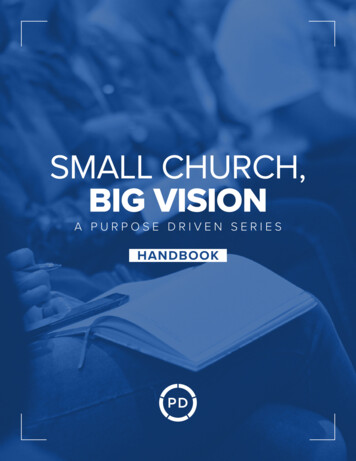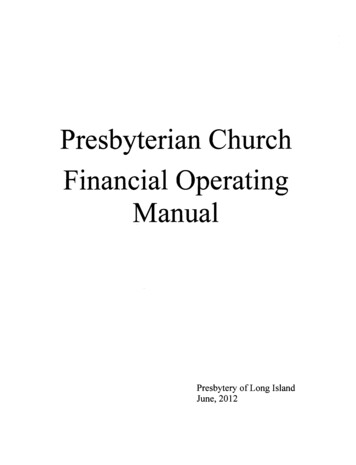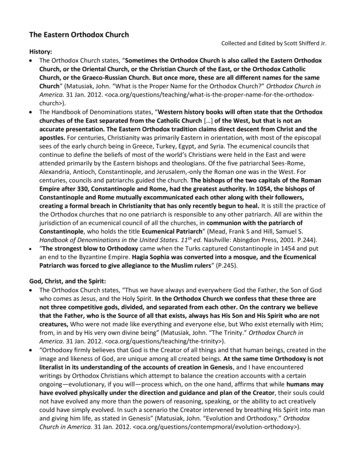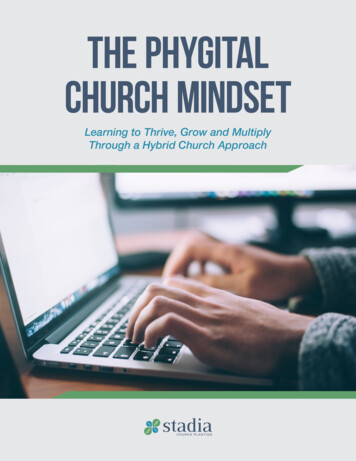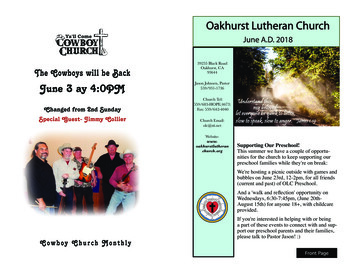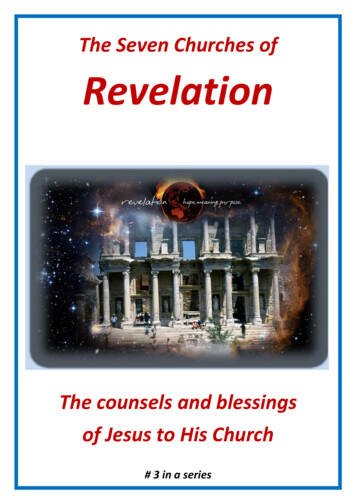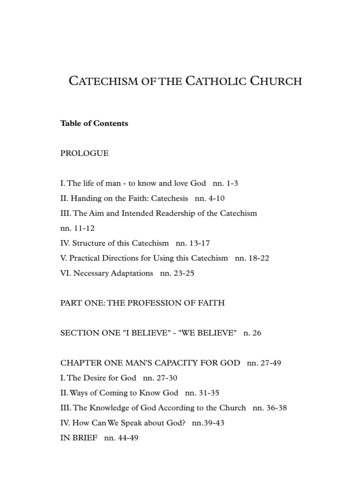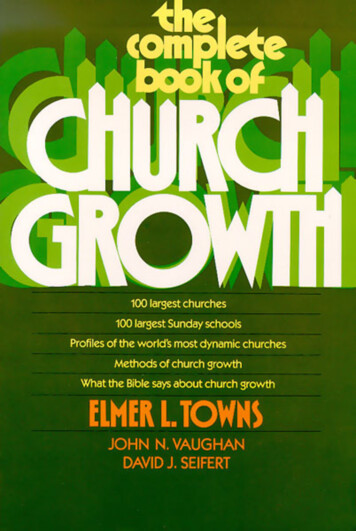
Transcription
The Complete Book of Church GrowthElmer Towns
CONTENTSPrefaceIntroductionPart I Church Growth in the Seventies and Eighties1.Sunday School and Church Growth in the Seventies2.Sunday School and Church Growth in the EightiesPart II Success Stories in Church Growth3.Theater-in-the-Round: Center Stage for the Gospel Melodyland Christian Center,Anaheim, California Ralph Wilkerson, Pastor4.Calvary Assembly-Fastest Growing Sunday School in the U.S. Calvary Assembly,Winter Park, Florida, Roy Harthern, Pastor5.God's Possibility PeopleCrystal Cathedral, Garden Grove, CaliforniaRobert H. Schuller, Pastor6.Los Gatos Christian ChurchLos Gatos Christian Church, Los Gatos, CaliforniaMarvin G. Rickard, Pastor7.A Warm Church in a Cold LandAnchorage Baptist Temple, Anchorage, Alaska, Jerry Prevo, Pastor8.Chile's SuperchurchJotabeche Methodist Presbyterian Church, Santiago, ChileJavier Vasquez, Pastor9.Elkhart's First Baptist GrowsFirst Baptist Church, Elkhart, Indiana, Dan Gelatt, Pastor10.People's Church Runneth OverPeople's Church, Fresno, California. G. L. Johnson, Pastor11.Imagine . 500,000 Church MembersFull Gospel Central Church, Seoul, KoreaPaul Yonggi Cho, Pastor12.The Church of the FutureThomas Road Baptist Church, Lynchburg, VirginiaJerry Falwell, Pastor13.Eleven Decisions That Produced GrowthBig Valley Grace Community Church, Modesto, California David Seifert, Pastor14.Grace Community Church: A Profile of MinistryGrace Community Church, Panorama City, California John McArthur, PastorPart III Church Growth in Church Groups15. Fundamentalism16. The Fuller Factor
17.18.19.20.21.Body LifeCharismatic RenewalEvangelical Bible ChurchesSouthern BaptistsMainline DenominationsPart IV Church Growth Methods22.Soul-Winning Evangelism23.Research and Scientific Analysis24.Prayer25.Bible Teaching and Edification26.The Holy Spirit27.Lay Involvement and Spiritual Gifts28.Aggressive Leadership29.Faith and Goal-Setting30.The Sunday School31.Social ActionPart V Church Growth and the Bible32.The Biblical Church in the Modern Age33.Pictures of the Church34.The Purpose of the Church35.The Priority of the ChurchPart VI Authorities Talk About Church Growth36.C. Peter Wagner, Growth Principles for a Soul-Winning Church37.Donald A. McGavran, Why Some American Churches Are Growing and Some Are Not38.Win Arn and Charles Arn, The Sunday School's Fight for Life39.Jerry Falwell, Growth of the Super-Aggressive Local Church40.Gene A. Getz, What Is a Mature Church?41.Tetsunao Yamamoril Factors in Church Growth in the U.S.42.D. James Kennedy, Evangelism43.E. S. Anderson, Discovering Growth PossibilitiesPart VII The Church Growth Lists44.The 100 Largest Churches in America45.America's Ten Largest Sunday SchoolsNotes and BibliographyAcknowledgements
PREFACEChurch growth is a modern phenomenon that crosses denominational and theologicallines. You can find it in every part of this country and other nations. It knows no ethnic orregional barrier.Because of these facts, everyone and everything having to do with the making of thisbook-authors, contributors, data, research, case studies-have come from diverse perspectives.The aim of the authors has been to examine growing churches, wherever those churches may be,and to acknowledge all possible reasons for that growth. This book includes some examples ofgrowing churches that embrace doctrines and life-styles with which the authors disagree. Also,the contributors to this volume by no means concur on the issues of church growth. It might besaid as well that the three authors come from various church backgrounds and differ on certainchurch matters, which, however, do not affect the fundamentals of the faith.In short, The Complete Book of Church Growth is not married to denominationalism orsectionalism. There is strength in diversity The reader can be assured that this book iscommitted not to the advancement of a particular church's view, but to the principle of growingchurches.The Complete Book of Church Growth is the most comprehensive book on churchgrowth in print. It combines statistical research with biblical exegesis and informed opinion toprovide student and layman with a complete, accurate, and contemporary view of churchgrowth. It is hoped that this book will succeed both as a research tool and as a practical guidefor churches, a map charting the good roads and the bad, the safe avenues to growth as well asthe treacherous ones.Dr. Elmer Towns is known for his research among large Sunday schools and is on thestaff of Thomas Road Baptist Church, an independent Baptist church that has grown throughaggressive evangelism.Dr. John Vaughan, a graduate of Southwestern Baptist Seminary (Ft. Worth, Texas) andFuller Seminary (Pasadena, California) is on the pastoral staff of Briarcrest Baptist Church inMemphis, Tennessee. Vaughan has worked in churches with memberships ranging from 50 to5,000 members and brings this perspective to the book. (Towns and Vaughan may disagree onthe application of the traditional laws of Sunday school growth, but they agree upon the basicstrength of these laws.)Dr. Dave Seifert is pastor of Big Valley Grace Community Church in Modesto,California, a Grace Brethren church that is growing through a balanced outreach. The strengthof his ministry is preaching and discipline. While he has one of the outstanding Sunday schoolsin America, his church has grown through his pulpit ministry. When Dr. Seifert went toModesto, the church was considered small by America's standards, but under his ministry, it hasmoved into the mid-size category Dr. Seifert, then, has been involved with both small and midsize church congregations in a small city.
And so, the experience and background brought to this book are considerable, theauthors well informed of that which they write. Indeed, the personal experience with actualchurch problems and dilemmas may be one of the most significant features of The CompleteBook of Church Growth.It is hoped that this project will prove valuable in the further discussion of church growthand that some of the ideas provided here will prod churches into new stages of numerical andspiritual development.
INTRODUCTIONChurch growth is a subject that rushed to prominence in the United States during the1970s. Certainly churches were growing before then; churches have been growing sincePentecost. But in past ages churchmen have been concerned about doctrine and spiritual life.Little was said about practical theology as manifested in the methods of ministry. Only in thelast decade has church growth become a matter of public and academic fascination.Why now? Well, ours is an age in which the American church has not been paid muchrespect. Gallup Polls have shown that Americans are losing confidence in their churches.Statistics have declined across the board: membership, attendance, offerings, recruitment of newclergy, and construction of church buildings. The religious life of the seventies has beencharacterized as despondent and deteriorating. However, some churches have grownphenomenally. These rare cases command people's attention. News that some churches havegrown and grown large has encouraged smaller churches in the U.S. and abroad. As a result,renewed attention has been focused on the church growth movement.The church growth phenomenon is a reaction to several trends in our society. First,America has given itself over to the measurement of institutions and the statistical evaluation ofeducation. We have developed standardized tests, percentiles, and median scores. It is perhapsonly natural that Americans would attempt to measure and analyze the church. Second, moreattention has been paid to the efficiency of organizations. It follows that the church too shouldbe studied in the light of improving its outreach and ministry. Third, there has been acommunication explosion in America. The time is right for journalism and media to focus onchurch decline and growth. The question is being asked: "Why are some churches growing andothers declining?"The Complete Book of Church Growth begins with an analysis of church growth in the70s, continuing with a research survey that investigates church growth trends for the 80s. Alongwith these chapters is a series of tables, located in Part VII at the back of the book, whichmeasures church growth in five areas: church membership, total church giving, attendance atSunday morning preaching services, Sunday school enrollment, and Sunday school attendance.Perhaps one of the most practical helps to the church worker or the church growthadvocate is to see churches in action. Part 11, "Success Stories in Church Growth," profilestwelve churches. These are churches of various sizes and different purposes, but each in its ownway is growing and maturing.Part III of the book, "Church Growth in Church Groups," examines church growth as itoccurs among fundamentalists, charismatics, Southern Baptists, and mainline denominations,among others. Part IV, "Church Growth Methods," explains how church growth is achieved.This chapter includes explorations of soul-winning evangelism, research and scientific analysis,aggressive leadership, and faith and goal setting. You may recognize some of these methodsfrom their use in your own church.
What does the Bible say about how churches grow? What pictures or images of thechurch do we find in Scripture? Then, how can these "church portraits" be translated intopractical, contemporary church methods? These questions are answered in "Church Growth andthe Bible," Part V of the book, in chapters on the pictures, purposes, and priorities of the churchas represented in the Word of God.Frankly, The Complete Book of Church Growth is not the only book on the subject.Actually, there have been several outstanding books on church growth in the past few years. Byreprinting some of these writings, the authors of The Complete Book of Church Growth hope tomake an exhaustive contribution to the discussion of church growth. Consequently, this bookincludes both original and reprinted articles from these leading authorities in the field: E. S.Anderson, Win Arn and Charles Arn, Gene A. Getz, D. James Kennedy, Leon Kilbreth, DonaldA. McGavran, C. Peter Wagner, and Tetsunao Yamamori. This makes up Part VI.It is hoped that The Complete Book of Church Growth will be a valuable resource in thestudy of church growth, that its parts, just described, have been arranged logically andefficiently, and that its thoughts and ideas amply reflect the illumination of the Holy Spirit.
ONESunday School and Church GrowthIn the SeventiesThe stage must be set by reviewing the past decade. In the seventies the Church/SundaySchool experienced rapid and uneven, yet segmented, periods of growth.1 While some churcheswere exploding in attendance, others in the same neighborhood were deteriorating in severalareas, of measurement.2 Then, as though several decades were compressed into a few years,some of the rapid-growing Sunday schools of the seventies declined as they approached theeighties.The Sunday schools that grew seemed happy, yet often they were unaware of the causesof their exploding growth. At the same time other Sunday schools worked hard for growth andeven emulated growing churches but were frustrated or discouraged because they could notgrow.Sunday school growth could be characterized as elusive and confusing. A few schoolsexperienced explosive growth, others marginal growth, but only a few seemed to understand thefactors that produced it: culture, theology, mobility, revivalism/emotionalism, leadership,advertising, national temperament, and sociological factors in church families ordenominations.3 Therefore, a look at the factors of Sunday school growth in the seventies isnecessary to lay a foundation for understanding Sunday school growth in the eighties.The big-church/Sunday school phenomenon is the first thing that must be analyzed.4 Atthe beginning of the seventies there was only one Sunday school averaging over 5,000 inattendance. Today there are five Sunday schools that size.5 Research has shown that onlytwelve Sunday schools averaged more than 2,000 in attendance in 1968.6 Today there are fortynine that large. The largest Sunday school in America is First Baptist Church, Hammond,Indiana, with a reported average attendance of over 15,101.The cause of these large Sunday school multimillion-dollar budgets has been analyzed.Some credit their appearance to American affluence, mobility, advertisement, or the influence ofnewly discovered ecclesiastical leadership by the pastor. Some have attributed their growth inthe last decade to the annual listing of the "100 Largest Sunday Schools" in Christian Lifemagazine or the book The Ten Largest Sunday Schools. They note that the attraction of thelisting's snob appeal motivated others to duplicate the same effort and build their church to thesame size.Others have said that America's failure in Vietnam was spiritual in nature, that the nationwas motivated to demonstrate its spiritual success, and that large churches were the best avenueof such achievement. However, the large-church phenomenon of the seventies had worldwidemanifestations, and none of the causal factors associated with American churches was evident inthe large churches/Sunday schools around the world.
During the early seventies the mainline denominations experienced a downward trend instatistical indicators. Toward the end of that decade, they bottomed out, but the indicators havenot yet pointed upward. Yet, some individual mainline denominational churches did grow incertain areas during the 1970s.What mainline denominational churches are doing wrong may give us a clue as to whatother churches are doing right. The cause of decline could be theological,7 bureaucratic,8 lack ofexcitement/commitment, lack of church planting, old facilities and/or location,9 or lack ofadaptation of new techniques to reach and evangelize.10As America entered the seventies, she was embroiled in a war in Vietnam with severerepercussions at home. The mood of the country was anti-institutional, which included an antichurch feeling. A speaker told the Greater Chicago Sunday School Convention, "By 1980 theSunday school will be functionally inoperative."11The influence of the "group dynamic" movement in the church was almost cultic in itsclaims, though it had its positive results. However, its anti-institutional mood reflected thetimes. As a result, some people advocated abandoning the traditional church and assembling insmall groups. People seemed to withdraw from churches of social success and power,especially those which could be measured quantitatively. There was a retreat to theinner/personal expressions of Christianity reflected in the Body Life and the living-room church.In this milieu, a new breed of rugged individualists known as "fundamentalists" rose toprominence. The pastor did not take his marching orders from society or denominationalheadquarters. He tried to win as many people to Christ as possible. He felt the evidence ofGod's blessing upon his life was manifested by a growing church, and he used every meanspossible to obtain that goal. He bought a printing press and mailed a church newspaper to thosein his neighborhood. He advertised extensively and purchased large plots of land for churchcampuses. He built buildings for the crowds. They sang enthusiastically and he preachedevangelistically. Sunday school busing became a characteristic of this type of church growth.The middle of the seventies marked a leveling off of fundamentalist growth.12 The Araboil embargo curtailed busing. Inflation eroded churches' extra money for advertising, employingstaff members, and general expansion. The investigation by the Securities and ExchangeCommission dried up the easy access these churches had to bond money. Hence, the building ofnew facilities slowed down.Strong "negative" preaching by fundamentalists contributed to their growth. Americansperceived that the nation's morals were slipping, and the public responded to the authoritativemessage of the fundamentalists. However, the success of their pulpit became counterproductiveby such tangential issues as the morality of pantsuits and long hair.Also, fundamentalists seemed to de-emphasize organization and administration as avalid means to a growing church. To them, the causes of growth are the pastor, soul-winners,Sunday school teachers, and paid staff members. Another reason for the mid-seventies
slowdown was that fundamentalist churches did not consolidate their gains by involving theirpeople in the work of the church, thus minimizing their efficiency.Church growth experienced by independent Baptists in the first part of the 1970s shiftedto many other conservative/evangelical groups in the last part of the decade. These other groupswere Southern Baptists, Nazarenes, Churches of God, Assemblies of God, and other churchgroups perceived as moderate in theology and posture. Many leaders in these groups confessedthat they learned about church growth from independent Baptists. However, an observation is inorder. These groups acquired the positive aspects of church growth without picking up itsliabilities. The moderate groups had a commitment to discipleship, organization andadministration, quality education, financial stability, and meeting the needs of their people in thetotal local assembly. When these groups studied the independent Baptists, they learnedenthusiasm, warm preaching, innovative techniques of outreach, and pastoral leadership.At the beginning of the seventies Sunday school attendance was usually larger thanSunday morning church attendance. However, at the end of the decade, the reverse was true;church attendance was almost universally larger than Sunday School attendance.13At the beginning of the 1970s Sunday school busing was introduced to the Christianeducation world as a technique of growth used by the independent Baptist churches. Quickly,most conservative denominations adapted busing as an outreach technique. But the Arab oilembargo was the main influence to reverse the trend. Also, those Sunday schools that hadgotten into busing for the wrong reasons found that busing was expensive, involved hard work,demanded extra teaching staff, additional facilities, and usually introduced to the Sunday schoolchildren from lower-class areas who brought discipline problems. Some Sunday schools foundthat the philosophy of busing evangelism was inconsistent with their established philosophy ofnurturing.14Busing will continue as a viable force among conservative churches that are committedto evangelistic outreach, especially within the transient areas of their society. It will not be aneffective tool for the larger and established churches and Sunday schools but will be employedby "first generation" churches with age-graded and departmentally graded Sunday schools.The energy problems of America could work to the advantage of the busing churches inthe eighties because busing will conserve gas, especially in light of possible rationing.15The growing Sunday schools of the eighties will be those perceived by the public asconservative/religious in nature, reflecting historic Christianity. This means they will beaccepted by the stable sections of society and will be visible, accessible, and dominant.
TWOSunday School and Church Growthin the EightiesPart VII of this book is a listing of the 100 largest churches and Sunday schools inAmerica, the result of research done to form a portrait of the church in the eighties.Originally, this research aimed to find the 400 largest churches in each of five areas(church membership, total church giving, attendance at Sunday morning preaching services,Sunday school enrollment, and Sunday school attendance). However, the researchers found thatin four of the five categories there weren't enough large churches to fill the listing. (Largechurches were arbitrarily identified by the figure 1200 or more.) Only in the category of churchmembership could 400 large churches be listed.This idiosyncrasy led the researchers to four conclusions:1. Churches regard membership as the most important measurement of church work.2. Americans do not transfer their membership from churches after they move from anarea, and many churches do not prune their membership lists.3. Church membership is a status symbol, thus producing more membership thaninvolvement.4. Some Americans join churches simply because of a social pressure "to do thereligious thing."Consequently, we can determine the number of large churches by measuring theirmemberships, but that does not often match up with the measurement of a church according toits attendance, giving, involvement, or the more elusive figure of persons' loyalty to theirchurch.The goal to list the 400 largest churches in each of the five categories had to be dropped.Instead 100 largest churches have been identified, all of which fall within the large churchcategory of 1200 or more.This research enables us to summarize seventeen facts about the church/ Sunday schoolas it stands today and to generate some predictions about what is likely to happen to theChurch/Sunday School in the 1980s.1. There are relatively few large churches. The lack of large churches in America (inall categories) can be established as an identifiable fact. Whereas many might have thoughtthere were more large churches because church attendance tends to be greater than Sundayschool attendance, the fact is there are not that many more.
Ten years ago, the prediction was made in The Ten Largest Sunday Schools that by 1980there would be 100 churches in America which averaged over 2000 in attendance. Some mighthave forecast an even higher figure. in fact, by 1980 there were only ninety-four churches inAmerica with over 2000 in attendance2. There has been a decline in Sunday school enrollment figures. In attempting togather material for this study, three facts became evident concerning Sunday school enrollment.First, enrollment in individual Sunday schools was not nearly as high as might be anticipated.This is because many Sunday schools are not placing as great an emphasis on enrolling childrenas in former days. Among Southern Baptists the stress on enrollment almost doubles thenumber of pupils in attendance. (Among other denominations the formula is not as reliable.)The lack of attention given to enrollment by individual Sunday schools indicates that feweraccurate predictions concerning Sunday schools can be made from enrollment statistics.Today, many Sunday schools do not even keep enrollment figures. A carefulexamination of the charts will indicate many Sunday schools are listed on the chart of the 100largest in attendance, but do not appear on the 100 largest in enrollment. Many of these Sundayschools use their mailing lists as the enrollment list. When this is done, we can question if thoseSunday schools are adequately following up their pupils, if they are adequately measuring thegrowth of their pupils, and if they are giving adequate attention to meeting the needs of thepupils.The third observation concerning Sunday school enrollment involves the denominationswhich no longer keep it. When research was done for the book, The Ten Largest SundaySchools (1969), it was almost impossible to compile the figures of average weekly Sundayschool attendance because most denominations did not keep the figures. At that time, it waseasy to secure the figures for Sunday school enrollment because most Sunday schools anddenominations kept that enrollment. However, the tables are now reversed. Today mostdenominations keep attendance and not enrollment. What has happened is that over the past tenyears Sunday school attendance has become paramount in the attention of statisticians. Eachyear, denominational officials have been requested to supply statistics for the fastest growingSunday school in each state and the 100 largest Sunday schools, which were printed in ChristianLife magazine. At the same time, denominational officials have indicated that very few peoplehave requested enrollment figures. As a result they have begun keeping attendance figuresrather than enrollment figures.Whereas it's difficult to draw conclusions from today's Sunday school enrollmentfigures, still we wonder if a deterioration process has not set in. Dean Kelly in WhyConservative Churches Are Growing indicates what has generally been known, i.e., that whenSunday school enrollment figures decline, eventually church membership follows the samepattern and also declines.3. The Sunday school is no longer a single-purpose organization. During the earlyseventies, Sunday schools were characterized for their dynamic strength in one area, such asbusing, auditorium Bible classes, contests, or other forms of aggressive outreach into the
community. These Sunday schools could be characterized as being single-purpose institutions.However, recent statistics have shown that Sunday schools which grew because of a singlepurpose could also plateau or decline because of a limited foundation. The busing Sundayschool was crippled by the Arab oil embargo and the rapid rise in fuel cost. The Sunday schoolbuilt on contests was handicapped with short-term growth because it put emphasis on the resultsit sought rather than on the conditions that would bring about the results. The Sunday schoolsthat continued growing throughout the seventies were those that were: (a) based on the Word ofGod, (b) based on meeting the needs of individuals, (c) had a solid New Testament concept ofevangelism and follow-up, and (d) were led by individuals who personified the goals of thechurch and had the ability to promote, persuade, and finance.4. The largest attendance has switched from Sunday school to the preaching service.Whereas in the early seventies most churches were growing because of their Sunday schools,this is seldom the case today. Actually, approximately 90 percent of most churches have largermorning services than Sunday school attendance. During the early seventies, the Sunday schoolwas the main outreach into the community. However, this is no longer the case. There areseveral reasons for this subtle shift in emphasis. First, the average American thinks that Sundayschool is for kids; they do not identify it with the total family. Second, the average American islooking for a metaphysical religion. They want a church that talks about the existence of God,sin, salvation, and the demands of a holy life upon their daily living. Most people find this inthe conservative, evangelical, fundamental churches. As a result, they have been attending thepreaching service because they were the most visible in the community. Now, the Sundayschool can no longer be the steeple which attracts people; it must be the foundation upon whichthe superstructure is built.5. Growth is built upon Bible study. The Sunday schools which have experiencedcontinual growth during the seventies have been those which have been built upon a systematic,comprehensive teaching of Scripture and doctrine. It is possible for a Sunday school tomushroom overnight, but many of those that did not have quality teaching soon topped out.Some reversed the trend. The Sunday school of the future should not have to sacrifice growthfor Bible teaching; both can operate together. Those church builders who feel they mustsubstitute growth for quality education are just as wrong as those who are so committed toquality education that they do not grow.6. A church member's attitude toward Bible study reflects the Church's attitude towardstudying the Bible in Sunday school. Fast growing Sunday schools that have neglected qualityeducation have not been able to sustain their growth nor keep their gains. Ultimately, a fastgrowing Sunday school without solid Bible teaching will plateau or decline in attendance.However, some have deceived themselves by making evangelism so important that they haveminimized Bible study- they justify their imbalance by stating, "At least we won some toChrist." One can ask if those who claimed to be converted but who dropped out of the churchwere in fact converted. And, did the church have such a deep commitment to the Bible after all,since it allowed those who made decisions to drop out?
As a result of this study, the researchers conclude that those Sunday schools with sloppyBible teaching could not be characterized as New Testament churches, no matter whatnumerical gains they have exhibited. Second, Sunday schools with high standards for qualityeducation reflect a church where people are desirous of the Word and probably studying theScriptures at home.7. Curriculum is absolutely essential for growth. When the book The Ten LargestSunday schools was written, only three of the churches used a prepared curriculum in theSunday school. The other seven wrote their own curriculum (“writing one's curriculum” isanother phrase for indigenous curriculum, i.e., that which is prepared by the local church for itsown use). However, nine of the ten churches used a prepared curriculum in 1980.The benefits of a Sunday school curriculum are apparent. It offers a systematic,comprehensive, complete coverage of doctrine, Bible knowledge, and Christian living. Whilethe researchers could find no cause and effect relationship between a good curriculum andgrowth, certainly there is a correlation. However, not all Sunday schools that experiencedgrowth are properly using a Sunday school curriculum. As a matter of fact, the opposite is true.There are many Sunday schools that use an effective curriculum but are not experiencinggrowth. This is another way of saying that one may build a foundation (curriculum) withoutbuilding a house (Sunday school growth). Not all of those who build a foundation go on tocomplete the house.Curriculum content will have a significant effect on Sunday school growth in theeighties. Th
3. Theater-in-the-Round: Center Stage for the Gospel Melodyland Christian Center, Anaheim, California Ralph Wilkerson, Pastor 4. Calvary Assembly-Fastest Growing Sunday School in the U.S. Calvary Assembly, Winter Park, Florida, Roy Harthern, Pastor 5. God's Possibility People Crystal Cathedral, Garden Grove, California Robert H. Schuller, Pastor 6.




